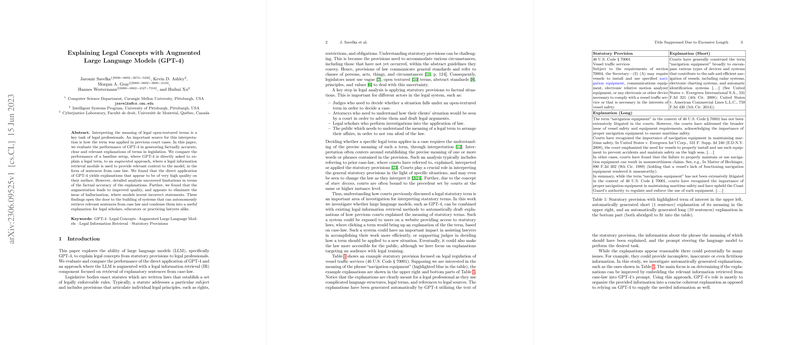Evaluating GPT-4's Capability in Legal Term Explanation with Augmentation from Case Law
Introduction
The paper presents an evaluation of GPT-4's performance in generating explanations for legal terms by comparing a baseline use of the model against an augmented approach incorporating external legal information retrieval. This work aims to enhance the understanding of statutory provisions by leveraging previous court interpretations, addressing a critical aspect of legal analysis. By integrating sentences from relevant case law into GPT-4's input, the paper seeks to improve the model's output in terms of factual accuracy and relevance, potentially aiding legal professionals in their interpretation tasks.
Methodology
The investigation centers around two primary questions: the limitations of direct explanations generated by GPT-4 and the impact of augmenting model prompts with case law information. The methodology involves a setup where GPT-4 operates under two conditions: a baseline that directly requests explanations based on the model's training corpus, and an augmented setup where the prompt includes targeted sentences from case law, aiming to provide contextually rich inputs for generating explanations.
Experimental Design
The paper uses a dataset comprising sentences from legal cases, classified by their relevance to interpreting specific statutory terms. These high-value sentences are then incorporated into the augmented model's prompt, offering a comparative analysis against the baseline model in how well each approach generates short and long explanations. The quality of these explanations is assessed by legal scholars across various dimensions, including factuality, clarity, relevance, and on-pointedness, to determine the efficacy of each method.
Findings
The augmented setup demonstrated a clear advantage over the baseline model in several key areas:
- Factuality: Incorporating case law significantly reduced the instances of hallucination, where the model generates plausible but incorrect or irrelevant content. This result underscores the importance of providing rich, relevant context to enhance the factual accuracy of the model's outputs.
- Clarity and Relevance: Though both models were capable of generating coherent explanations, the augmented model's outputs were consistently deemed more relevant and clearer, suggesting that the context provided by case law positively influences the model's focus and understandability.
- Information Richness and On-pointedness: The augmentation contributed to a noticeable improvement in the depth and focus of the explanations, offering a more nuanced understanding of legal terms than the baseline approach.
Implications and Future Directions
This paper's findings indicate that leveraging GPT-4 in conjunction with specialized legal information retrieval methods can substantially improve the quality of generated explanations for statutory terms. This hybrid approach promises to enhance legal education, research, and practice by providing accurate, context-aware explanations that closely align with professional standards. Future research could explore refining the legal information retrieval component to address identified limitations and extending the augmented model's application to other legal tasks for broader utility.
Conclusion
The paper contributes significant insights into the potential of augmented LLMs in legal settings, highlighting how the integration of case law can mitigate common limitations of direct generative approaches. By improving the model's access to relevant, factual content, augmented systems offer a promising path towards developing AI-assisted tools that support legal professionals in their interpretative work. This approach not only advances the capabilities of AI in legal applications but also underscores the value of interdisciplinary methods in enhancing AI's practical and theoretical contributions to the field.
